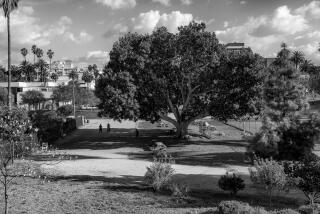Gardening : Lemons Tops for Garden, Kitchen : Citrus: Caught between dwindling supply and growing demand, lemons have risen in price. Avoid the problem by planting your own.
- Share via
Don’t let the price of lemons put a squeeze on your budget--fight back with your own lemon tree. According to Don Dillon, a wholesale citrus tree grower, lemon trees are by far the biggest sellers among the 30 citrus varieties he supplies to nurseries and garden centers.
The popularity of lemon trees results from two factors: the price of lemons has risen steadily at the supermarket over the past two years, and lemon trees are among the most attractive of all citrus trees when used in a landscape.
The reason for the rise in lemon prices is simple--supply and demand. Lemon groves are disappearing rapidly to make room for housing and commercial developments, while at the same time consumers are eating more fish and seafood, and also using lemons instead of salt in their diets.
The landscape potential of lemon trees is marvelous. The trees are evergreen and produce pretty, fragrant blossoms and glowing yellow fruit that contrast nicely with the dark foliage. If you lack yard space, a dwarf or semi-dwarf tree will fit nicely in a small yard or large container. Lemon trees may be pruned or espaliered to create imaginative landscape designs.
The home gardener can select from five lemon varieties, which range from the usual to the exotic. The trees vary in size from true dwarf (6 to 8 feet), semi-dwarf (8 to 12 feet) and standard (15 to 25 feet). Most trees sold as dwarf are actually semi-dwarf trees. The five varieties include:
--Improved Meyer. This is a highly ornamental and most productive tree. It is one of the few citrus trees that has natural dwarfing tendencies and does not require special rootstock to produce a small tree.
The Improved Meyer lemon has an orange in its ancestry and the fruit is sweeter than a true lemon, but still has an excellent flavor. It is thin-skinned and very juicy. Improved Meyer makes a superb container tree.
Besides of its other attributes, the Meyer lemon is more widely adapted to the various climatic zones of the Southland than any other variety.
--Eureka. A very important commercial lemon and a particularly good choice for coastal valleys where it produces fruit and blossoms nearly year-round. The exceptionally handsome tree produces medium-sized, yellow fruit with a good acid flavor. The Eureka is frost-sensitive and not a good choice for the colder inland valleys.
--Lisbon. A very vigorous and highly productive tree tolerant of both cold and hot weather. It is a good choice for inland valley and desert areas. The foliage is dense and the blossoms are tinged with purple and quite attractive. The fruit is juicy with a great deal of acidity.
--Ponderosa. An interesting novelty tree, this lemon-citrus hybrid produces a fruit that often weighs several pounds, has a thick rind and is not very juicy. For fruit production, Ponderosa is not a good choice. However, the small trees are highly ornamental.
--Sungold. This is a dramatic new lemon tree that would be a focal point in any landscape. Both the leaves and the fruit of Sungold are variegated--the leaves are streaked with yellow and the fruit is streaked with green. The two-tone combination is most attractive.
Sungold is a patented variation of the Eureka lemon and has similar production and climatic requirements. As it is a fairly new introduction, the trees may be scarce. Your local nursery can probably order a tree for you from a wholesale grower.
Purchase only healthy, vigorous-looking trees. Avoid trees with long trunks and those with branches concentrated at the top. The tree should have good skirt branches near the soil line. If the transplant has any fruit on it, pick it off so that the tree’s energies will be devoted to foliage production.
The tree must be planted in a sunny area. Dig a hole twice the diameter of the root ball. The new tree should be set at a depth similar to its depth in the nursery container. Place the tree in the planting hole and make certain that the grafting union is about three inches above the soil line. Add time-release fertilizer planting tablets to the soil. Refill the planting hole with the soil you removed. When you are finished, make certain the tree gets a good soaking.
In hot-sun areas, whitewash the trunk to prevent sunburn, or try wrapping it with trunk band.
Newly planted trees should be watered moderately twice a week for the first month. Established trees should be irrigated weekly, except in the winter if rainfall is plentiful. Feed lemon trees with a citrus fertilizer in March and again in July.






